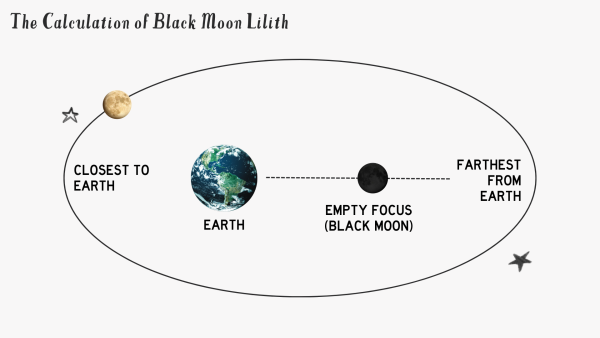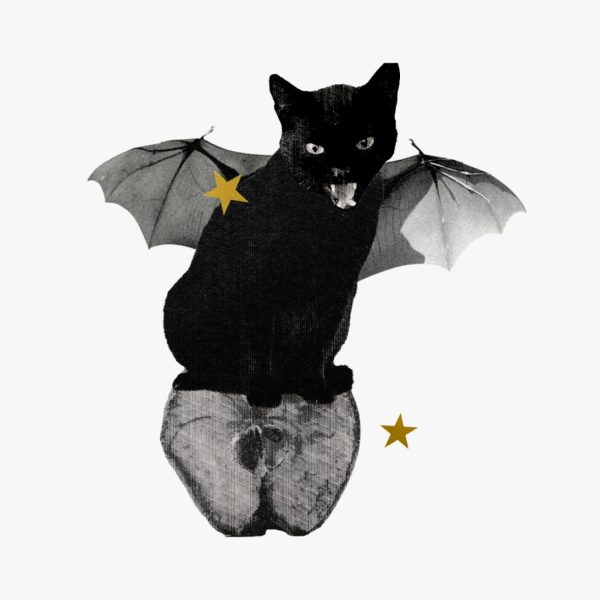Everything you need to know about the cosmic wild one
What: Black Moon Lilith, the untamable and mysterious shapeshifter, offers the keys to our shadows and our power.
Takeaway: By understanding your Black Moon Lilith placement, you can pinpoint the parts of yourself that feel shunned, neglected, and righteously angry. Along with self-awareness and constructive outlets for expression, Lilith can help you access your potency, your instincts, and your autonomy.
Understanding the archetype of Black Moon Lilith
In modern astrology, Black Moon Lilith has come to represent the untamable, feral spirit of those who’ve been exiled from dominant social structures. The outsiders, the outcasts, and the marginalized who flourish in our culture’s figurative underground. The people who refuse to sand down their sharper edges or submit to systems of supremacy — even when that defiance comes at a cost. Lilith is at home in the stories that have been silenced, the redacted parts of the text, and the facets of life that we suppress. Lilith is as ungovernable as the dirt, the shadows, and the wild Earth itself.
Which Lilith is which
Black Moon Lilith isn’t a planet, an asteroid, or any kind of celestial body — though many versions of Lilith exist, as you will discover. Like the lunar nodes, Lilith is a symbolic, bodiless point in our skies.
You might think of the Moon’s orbit around Earth as a perfect circle, but it’s actually more like an oval or ellipse. That means it has two focus points. One of them is the Earth. The other — a ghostly counterpart to our planet — is Black Moon Lilith. This empty point in space hovers close to the lunar apogee, the farthest point from Earth in Luna’s orbit. Considering Lilith’s connection to exile and wildness, this distance from the familiar realm of our world is apt.

We have both true and mean lunar nodes, and the same goes for Black Moon Lilith. The Moon’s elliptical orbit around the Earth isn’t perfectly even; it wobbles. The mean calculation of Black Moon Lilith is based on the average of these wobbles. The true calculation captures Lilith’s exact position, wobble and all. Neither calculation is better than the other; it’s up to the astrologer to choose which Lilith they prefer to work with.
In practical terms, mean Black Moon Lilith slowly and consistently travels forward through the signs, so its movement is easier to predict. True Black Moon Lilith, however, stations retrograde about once a month. That means it tends to zigzag back and forth over the same territory for months at a time, while the mean point steadily advances onward. In both cases, Black Moon Lilith takes about nine months to move through each sign and nine years to cycle through the whole zodiac. But the true point is more erratic, flashing in and out of the same two or three signs as it gradually progresses. Think: one step forward, two steps back.
At CHANI, we use true Black Moon Lilith, so you might notice this point reappearing in your Transits in the app multiple times within a given month. Also bear in mind that the distance between true and mean Black Moon Lilith can vary pretty dramatically, possibly showing up in different signs and houses in your chart.
To make matters even more complicated, there are also other astronomical points connected to the Lilith archetype — though we work with only Black Moon Lilith at CHANI. This point is not to be confused with the similarly named Dark Moon Lilith, aka Waldemath Lilith, which was identified after controversial sightings of a mysterious second Moon orbiting the Earth. This alleged Moon has since been debunked, for the most part — some sources attribute it to a smudge in the astronomer’s telescope.
There’s also an asteroid named Lilith — the only physical body linked to this archetype. It orbits in the asteroid belt between Mars and Jupiter, but like the Dark Moon / Waldemath Lilith point, it’s not in popular use among astrologers.
To reiterate, because it’s oh so easy to get confused about the many Liliths in the sky: We use true Black Moon Lilith — not the mean point, not the apocryphal Dark Moon, and not the asteroid.
Lilith’s historical lineage
Adding to these mysteries and ambiguities, different cultures have created many myths and folkloric superstitions about Lilith. Although this archetype has ancient roots, its rehabilitation in astrology is a modern development. As we explore the history of Lilith, we find that the astrological symbol draws inspiration from a tapestry of millennia-old stories. In fact, this archetype predates writing — it’s even older than the alphabet.
Lilith was first represented in the earliest poems about Inanna, written around 2000 BCE in ancient Sumer. In one such account, Inanna — the Sumerian Goddess of love, war, and fertility — plants a huluppu tree, which she intends to use for making a throne and marriage bed. But the tree is occupied by a serpent, an Anzu bird (a lion-headed eagle), and “the dark maid Lilith” herself (she is often associated with snakes and winged creatures). Inanna is none too pleased by these intruders, and she calls upon the hero Gilgamesh to cut down the “infested” tree. Lilith flees the wreckage of her home in Innana’s cultivated garden to an exile in a deserted land. Such outcasting is a persistent motif in Lilith’s lore and in modern interpretations of this archetype.
The etymology of Lilith is also telling. The name Lilith comes from the Akkadian Lilitu, meaning “of the night.” In Jewish folklore, Lilith appears as a sexually voracious, nocturnal demon who brings storms, diseases, and the deaths of babies. This wild, untamable, autonomous woman now represented a threat to the family. She was considered evil, dangerous, and blasphemous. Pregnant parents even wore amulets to protect their fetuses from Lilith. Such stories could account for the more shadowy depictions of Lilith as a vamp, a femme fatale, a scapegoat, and a barren woman.
The most iconic installment in Lilith’s complex lore comes from the Alphabet of Ben Sira, a Hebrew book in which Lilith is the first wife of the biblical Adam. Anonymously written in the Middle Ages, and likely intended to be provocative and satirical, the tale describes Lilith emerging from the soil itself — like Adam, but unlike Eve, who would be transformed into a human from Adam’s rib. In this parodic story, Lilith’s existence is not contingent upon Adam’s because she is of the Earth too — and therefore his equal.
Tension arises when Lilith raises this issue to her husband and refuses to lie beneath him in the conjugal act. When Adam declines to recognize and respect her authority, Lilith voluntarily exiles herself to the Red Sea and eventually gives birth to a brood of demonic babies. As a grim punishment for Lilith’s defiance, God’s avenging angels vow to kill 100 of the infants every day of Lilith’s disobedience. Just as Black Moon Lilith serves as a counterpoint to the Earth within the Moon’s orbit, Lilith appears in this story as a potent foil to an all-powerful, all-light, all-knowing, all-good, male god.
Making sense of Lilith today
Though the myths of Lilith range from the macabre to the absurd to the downright harrowing, it’s important to remember that these stories are not to be taken as literal models in our own lives. However, they do capture some of the most intense dimensions of the human experience. Most of us understand how it feels to be outcast, othered, or unfairly treated. But Lilith also invites us to resist the forces that leave us feeling alienated, atomized, and disempowered within cultures of supremacy.
Lilith is the protector of all who live on the margins and all who refuse to be ground down or declawed by oppressive structures. Reflecting the themes of this archetype, Black Moon Lilith in your natal chart can hint at where you tend to be defiant, untamable, and fiercely independent. It’s a subtle pulse point in your birth chart, one that signals your deepest, most authentic urges.
When Black Moon Lilith transits part of our natal chart, it can also indicate a moment when these themes are activated in our lives — when we might feel a little left out, projected upon, or angry. Trying to suppress such emotions is a waste of time, but great power is available to you if you pay attention to that shadowy energy and channel it.
Just as Lilith was banished from Eden and the huluppu tree, many of us have also been exiled from our own wildness, severed from the instinctive knowledge of our animal bodies, and forced to commodify and curate every part of ourselves instead of embracing the unknowable. By learning about your natal Black Moon Lilith, you have an opportunity to reclaim the parts of you that are exquisitely untamed.
7 ways to work with Black Moon Lilith
Wherever Black Moon Lilith resides in your chart is a site of resistance, defiance, and your deepest shadow work. Remind yourself where that is by pulling up your chart in the CHANI app. Then get to know your Lilith placement with the help of these tips:
- Discover the sign and house of your natal Black Moon Lilith by checking out your Points & Minor Planets in the Me tab of the CHANI app. This is also where you can check if you have any conjunctions between Black Moon Lilith and other natal planets or points.
- Explore what rings true for you by journaling, comparing Lilith placements with friends, or studying the biographies of famous figures with notable Lilith placements. By doing so, you’ll better understand the raw edges of both yourself and your besties. If something feels unsettling, move toward it — or at least take notes.
- Reclaim your wild parts by strengthening your connection to the natural world or loosening your attachment to other people’s opinions. Gossip with crows. Start a windowsill herb garden. Dress without a code. These practices can reaffirm the ways you don’t fit within prefabricated boxes — and don’t need to.
- Refuse oppressive power structures (when it’s safe to do so). That could mean attending a protest, donating to an organization whose mission you believe in, or calling out someone who’s made an inappropriate joke. While they can be intimidating at first, such efforts solidify your agency and authority.
- Work constructively with your grief and rage by delving into cathartic creative outlets and conjuring art from your shadows. Whether you forage nettles for your next tincture or pour your heart into a confessional poem, angry letter, or manifesto, Lilith can help you alchemize feelings of rejection, neglect, fury, and pain.
- Collaborate with community members who feel overlooked, misunderstood, or disenfranchised. Whether you’re initiating a union action, advocating for tenancy rights, or circulating provocative zines, remember that interconnection offers the keys to your liberation. Though Lilith isn’t afraid of isolation, joining forces with like minds and hearts can be potent medicine.
- Get curious about the parts of yourself that trigger shame, insecurity, or vulnerability. Under every fear or self-sabotaging pattern, there’s an origin story to unearth. Though sifting through our shadows is rarely comfortable work, whatever festers in darkness tends to disperse when we bring it to light.
Looking for more intel? Read your daily horoscope:
Aries | Taurus | Gemini | Cancer | Leo | Virgo | Libra
Scorpio | Sagittarius | Capricorn | Aquarius | Pisces
Then download the CHANI app on iOS or Android for additional horoscopes, meditations, affirmations, readings for the current Moon phase and sign, and more.


